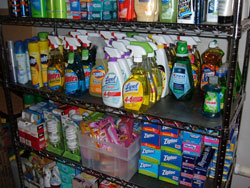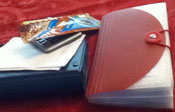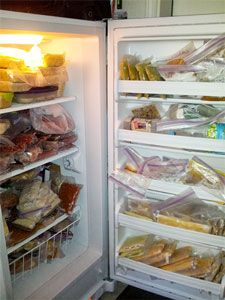Stockpiling: The New Way To Shop
Though a common activity for centuries, stockpiling has particularly been made popular in the last couple of years with shows such as TLC’s Extreme Couponing. While some stockpile in case of a natural disaster, others simply do so to save money in the long run. Keep reading to learn more about how to stockpile food and household items effectively and efficiently. So let’s start with….
What is Stockpiling
Derived from the two words “stock” and “pile”, stockpiling is essentially the storing of supplies in bulk. Keep in mind that a stockpile can’t be built overnight and takes instead several weeks, if not months or even years to fully develop into one’s own personal convenience store. Many of us can understand the desire to stockpile after visiting an especially attractive sale on non perishable goods, where as most of us end up buying one or two items, serious stockpilers will fill up their shelves in order to save on those products in the long run. So let’s move on to…
How to Stockpile
 The thought of starting a stockpile can be an overwhelming one when you consider all the intricacies. However, everyone’s stockpiles are different and depend largely on each family’s needs. Does your family go through toilet paper like there’s no tomorrow and you often find yourself using kleenex instead? Or are paper towels always lacking when a mess needs to be cleaned?
The thought of starting a stockpile can be an overwhelming one when you consider all the intricacies. However, everyone’s stockpiles are different and depend largely on each family’s needs. Does your family go through toilet paper like there’s no tomorrow and you often find yourself using kleenex instead? Or are paper towels always lacking when a mess needs to be cleaned?
Make a list of all the items that your family simply can’t go one day without and put it at the top of the list. Do the same for food but keep in mind shelf life and be sure to Google anything you’re unsure about (i.e. ‘how long can rice be stored’).
 A price book may also come in handy as remembering the prices for all the products you need can be challenging. The idea here is to purchase your needed items at rock-bottom prices and to hopefully (if you are a skilled couponer) add on top of this as many coupons as possible. So, buy in bulk as much as possible (there are quite often limits imposed by the stores) because while it may seem like more at checkout, you won’t have to buy that item for a while, and you would have more than likely saved money on each item as well as the added convenience.
A price book may also come in handy as remembering the prices for all the products you need can be challenging. The idea here is to purchase your needed items at rock-bottom prices and to hopefully (if you are a skilled couponer) add on top of this as many coupons as possible. So, buy in bulk as much as possible (there are quite often limits imposed by the stores) because while it may seem like more at checkout, you won’t have to buy that item for a while, and you would have more than likely saved money on each item as well as the added convenience.
Here is a tip we learned from working at a grocery store; Stock rotation. Be sure to rotate products by placing the newly bought ones at the back of the pile and use a marker to write the date of purchase on each item–trying to remember when you bought it months later will be no easy feat!
Keep in mind that there are countless tools and resources to find all the best in-store coupons and specials such as grocery list apps, which even send notification as soon as printable coupons are released (if you ask nicely in a comment I will build a resource for you). Don’t forget to pick up the flyer at your local grocery stores and pharmacies (the latter usually sell non perishable goods slightly cheaper). Newbies often make the mistake of buying in bulk any item they use frequently when they are on sale, but it is important to understand….
What Can Be Stockpiled?
Food can be a tricky thing to stockpile and while it may require a bit of trial an error at first, eventually, you will simply know whether to stockpile a specific product or not. Most importantly, take into consideration shelf life. Canned foods for instance can last up to 10 years! Either way, cooking from scratch can be a challenge with an empty pantry, which is another reason why a stockpile would come in handy.
As we mentioned in tip #8 of the 34 Tips to Trim the Grocery Bill, buying products such as cereal and rice in bulk would be great for a stockpile but also as a way to save money in the long-term.
Food aside, there are also plenty of other items that can be stockpiled such as back to school supplies (notebooks and crayons).
Items that have a short shelf life on the other hand should be avoided. Wasting food and therefore money is in no ones best interests. My rule of thumb is that if it lasts less than 6 months I don’t stockpile it. And I make sure to check my stockpile (and I mean really look at it) every few weeks to make sure nothing is going to go bad.
Stockpiling in the Freezer
 From garlic to eggs and even milk, so much can be frozen, but once again, we simply can’t stress enough that this depends on your family’s needs and freezer size. Also, stockpiling for the sake of doing it is never a good idea. Make sure that you will actually be using the frozen products and consider making an inventory of what you have frozen and when.
From garlic to eggs and even milk, so much can be frozen, but once again, we simply can’t stress enough that this depends on your family’s needs and freezer size. Also, stockpiling for the sake of doing it is never a good idea. Make sure that you will actually be using the frozen products and consider making an inventory of what you have frozen and when.
As a general rule of thumb, avoid freezing fruits and vegetables with a high water content (i.e. oranges, lettuce etc.) as well as condiments that are sure to break down and separate such as mayonnaise.
Also, make sure to label everything with the date of freezing as it can get particularly tricky when trying to decide whether it’s still good or not. A Foodsaver or even a deep freezer may be viable options as well down the road, especially if you find yourself freezing a lot of food.
Don’t Overdo It
It’s easy to get carried away when stockpiling once you start thinking about all the money you will save in the future. However, carefully consider your family’s needs first and be sure to take into account the amount of time until the product expires. If the deal is simply too good to pass up, then donating to charity is always a much advocated for option by stockpiling enthusiasts.
I would love to see some pictures of your first stockipile! Send us a link in the comment section below.

No Comments